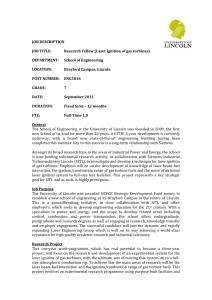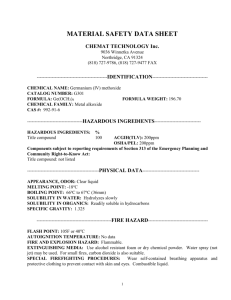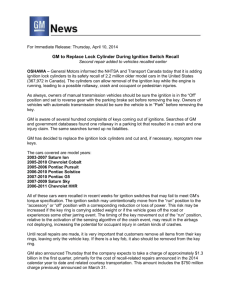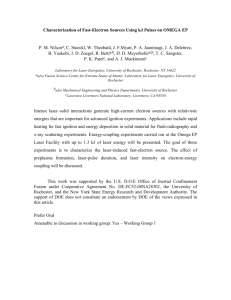Shock Ignition
advertisement
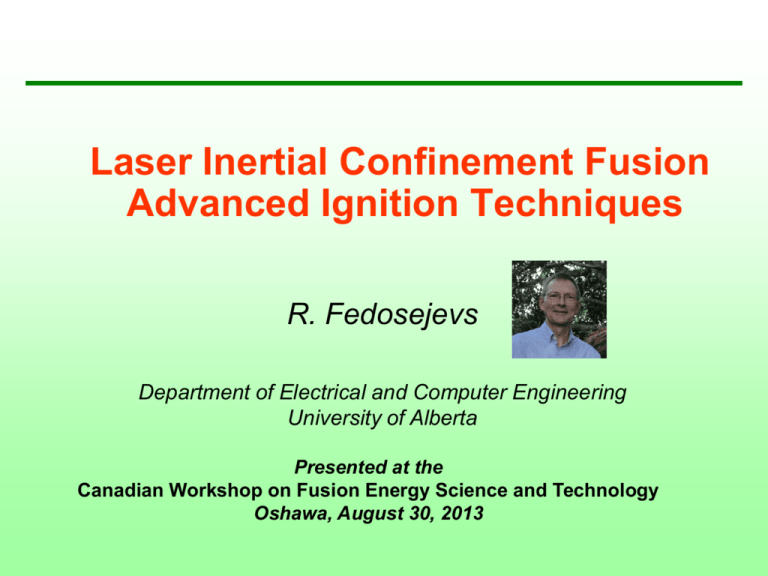
Laser Inertial Confinement Fusion Advanced Ignition Techniques R. Fedosejevs Department of Electrical and Computer Engineering University of Alberta Presented at the Canadian Workshop on Fusion Energy Science and Technology Oshawa, August 30, 2013 Overview • • • • • • Introduction to Laser Fusion Energy Advanced Ignition Techniques • • Fast Ignition Shock Ignition Status and Issues Our Recent Experiments on Fast Ignition and Shock Ignition The Way Forward Conclusions Fusion Energy - Bringing the Sun to Earth The Ultimate Energy Source http://photojournal.jpl.nasa.gov/catalog/PIA03149 Deuterium Based Fusion 1 part in 6500 of all hydrogen is in the form of deuterium 3 water bottles of DT water fuel and 400 helium balloons ash per day for a GW reactor Lawson Criterion for Net Energy Yield Requires very elevated temperatures ~100,000,000 K ( ~10keV energy per particle ) Requires enough burn time Lawson Criterion for net release of more energy than heating energy n t ~ 2 x 1014 s cm-3 n = ion density, t = confinement time Laser Fusion uses high density n ~1025 cm-3 but short interaction time t ~100 ps in the ignition hot spot Inertial Confinement Fusion (ICF) Approach Laser Fusion Energy (LFE) Laser Fusion Direct Drive Ignition Conditions: r ~ 400 g cm-3 Indirect Drive T ~ 6 keV In central hot spot region Lawrence Livermore National Laboratory National Ignition Facility - USA Goal to reach ignition and produce modest target gains of G = 10-20 • Indirect Drive 1.8 MJ • 0.35 mm 196 beams • Operating 3 years Lawrence Livermore National Laboratory https://lasers.llnl.gov/ Laser Bay NIF-0411-214554.ppt https://lasers.llnl.gov/ Laser Mega Joule - France • 0.35 mm Indirect Drive - Under Construction • Initial phase 166 beams at 1.2 MJ • First shot on target 2015 • Full facility 240 Beams 2 MJ possible in future http://www-lmj.cea.fr/ Proposed European HiPER Project Advanced Ignition Demonstration Experiment http://www.stfc.ac.uk/906.aspx / Cost ~ $1B Euro Planning Started under the Framework 7 Program LLNL LIFE Power Plant Design Addresses Engineering Requirements for a Real Reactor) Plant Primary Criteria (partial list) Cost of electricity Rate and cost of build Licensing simplicity Reliability, Availability, Maintainability, Inspectability (RAMI) High capacity credit & capacity load factor Predictable shutdown and quick restart Protection of capital investment Meet urban environmental and safety standards (minimize grid impact) Public acceptability Use of commercially available materials and technologies Focus on pure fusion, utility-scale, power-producing facility Timely delivery LLNL : Initial engineering and planning already carried out 12 https://lasers.llnl.gov/about/missions/energy_for_the_future/ LIFE translates the “single shot” capability of NIF into the requirements for ~1000 MW electrical output Laser driver Heat transfer 900 cycles / minute provides ~ 1 GWe output 13 Tritium recovery https://lasers.llnl.gov/about/missions/energy_for_the_future/ NIF Indirect Drive Status • • • • Best neutron yield of 3 x 1015 obtained to date ITFX parameter of 0.16 achieved ( 1 = threshold but scales very strongly with a number of parameters) Appears Implosion symmetry not good enough yet • need higher resolution x-ray imaging diagnostics In progress: (2015 next DOE program review) • • • • Adjusted shape hohlraums Smoother targets Diamond and Be ablators instead of plastic More stable lower adiabat implosions (thicker shells) Rochester Direct Drive Status • University of Rochester Laboratory for Laser Energetics (LLE) – lead lab for direct drive in world • • • • 30kJ symmetric implosions at 0.35 mm Conducting polar direct drive experiments at NIF at 1 MJ level – potentially could achieve ignition after reconfiguration of optics and modified front end laser at 1.5MJ Best neutron yield of 2 x 1013 obtained to date Scaled ITFX parameter of 0.24 achieved • Fuel compression not good enough yet: hot spot rR = 0.2 g cm -2 (vs 0.3 g cm -2 required) • • Fuel preheat from burst of hot electrons from laser plasma interaction in corona Will improve conditions using: • • Variable Z layer targets to reduce hot electrons and fuel preheat Smoother targets Advanced Ignition Techniques Fast Ignition Fast Ignition – An Improved Approach Ignition Requirements Long Pulse Compression ~ 500kJ Short Pulse Ignition ~200 kJ r ~ 300 g cm-3 tdep ~ 20 ps Ddep ~ 40 mm Edep ~ 20 kJ Elaser ~ 200 kJ Proposed by Tabak in 1994 Requires: electrons (1-3 MeV) or ions (15-20 MeV) To carry the energy from the laser absorption region to the high density compressed core flaser ~ 20 - 40 mm Ilaser ~ 1020 – 1021 W cm-2 Energy Gain Scaling for Fast Ignition Reduce Laser Requirements almost an order of magnitude: Smaller and less expensive initial IFE reactors possible Initial Heating Results Demonstrated at ILE Japan Kodama et al., Nature 418, 933 (2002) Electron Energy Scaling Required electron energies ~ 1-3 MeV Scaling Laws: Wilks (Ponderomotive) PRL 69, 1383 (1992) Wilks 1 mm 0.5 mm Ideal 1-3 MeV range Haines Beg (Exp Bremsstrahlung) Phys.Plasmas 4,447 (1997) Haines (Energy/Momentum) PRL 102, 045008 (2009) Beg Fast Ignition with Electrons 1. Conversion efficiency to energetic electrons Experiments indicate 10% to 60% (various conditions) 2. Electron temperatures Experiments indicate temperatures in range (2-10 MeV) Requires 2nd harmonic wavelength 3. Coupling of electrons to core Experiments indicate 10% – 30 % efficiency -> Requires enhanced magnetic guiding Using magnetic fields from self driven currents External magnetic fields of ~10 MG Proton Fast Ignition with Protons Required proton Energies ~ 15-20 MeV • Need Conversion efficiency from laser to protons of 10% • Only achieved in a few experiments to date • Need to demonstrate guiding and coupling to the core Shock Ignition Shock Ignition • • • Strong shock at the end of the compression pulse causes ignition of compressed fuel core Recently proposed in detail in 2007 by Betti et al. (PRL 98, 155001 (2007)) Similar Concept by Shcherbakov, Sov. J. Plasma Phys. 9(2) 240 (1983) High Gains at Low Pulse Energies European HiPER Facility Conceptual Designs 1. 2. 3. Compression laser 250 kJ, 4ns, 3w Shock Ignition laser 60 kJ, 400 ps, 3w Fast Ignition laser 100kJ, 15ps, 2w Compression + shock ignition = 48 focal spots Fast ignition = Single Cone 26 Shock Ignition • Three critical requirements • Minimize backscatter from plasma instabilities in order to absorb greater than 50% of incident energy • Control the hot electron preheating of the compressed fuel core • Obtain good hydrodynamic coupling efficiency to drive strong shock • Theory ,simulations and experiments to date look promising • Possible benefit in reduced Rayleigh Taylor instability levels • Also possibly polar direct drive could be used for the shock pulse High Gains at Low Pulse Energies Yield in MJ versus shock launch time (ns) and absorbed power in 0.5 ns shock spike Multi-MJ yield versus absorbed power in 500ps spike Atzeni Nuclear Fusion 49, 05500, 2009 Shock Ignition for LMJ and NIF 33.2 49 59 • 1.2 MJ, 390 TW • 40 quadruplets (33°, 49°) 160 beams 40 x 40 cm2 • May be split and repointed Ribeyre et al., Plasma. Phys. 121 Control. Nuclear Fusion 51, 131 015013step: (2009 Second 146.8 Shock ignition Ignition http://www-lmj.cea.fr/ 49° First step: Target compression 33.2° at low velocity PDD- LMJ 250 km/s 2 rings Also LLE point design for 700 kJ G =38 with PDD with SI on NIF Polar Direct Drive configuration: Need to have a good laser uniformity < 2% ? Converging shock Front Diverging shock front Need to generate a strong shock 200-300 Mbar 1-5x1015 W/cm2 (3w) Absorption and Plasma Instabilities Absorption Mechanisms • Main Absorption for long pulse through collisional Inverse Bremsstrahlung (IB) absorption • For short shock ignition pulse absorption both through IB and plasma instabilities: • • Stimulated Brillouin scattering leading to heated ions 1 keV • Stimulated Raman scattering leading to 10 - 100 keV electrons • Two plasmon decay instability leading to 20-100 keV electrons These plasma instabilities lead to significant back reflection of radiation of the order of 10-50% combined Stimulated Raman Scattering (SRS) Electron plasma waves Incident light Electrons from wave breaking Reflected light Density profile (interaction up to nc / 4 maximum density) Threshold and Growth Rate ( cosc0 ) 2 v 2 k 0 Ln 2 I16 um um44Lnmm w2 cv ( nn )1 / 4 5 1014 I161 / 2 ( nn )1 / 4 s 1 0 osc e e 0 c c For 0.5 mm Light incident on 200 mm scale length plasma Threshold ~ 4 x 1015 W cm-2 Growth rates ~ 3.5 x 1014 s-1 at 1016 W cm-2 W. Kruer, Physics of Laser Plasma Interactions (1988) Stimulated Brillouin Scattering (SBS) Ion Acoustic waves Incident light Reflected light Density profile (interaction just below nc ) Threshold and Growth Rate ( vosce ) 2 v 2 1 2 k0 w0 c s 8 k 0 Ln I16 um 0.34 Lnmm 1/ 2 14 I16 um (vosc w pi ) 1.4 10 1/ 4 TkeV TkeV ( nce )1 / 2 s 1 n For 0.5 mm Light incident on 5 keV, 200 mm scale length plasma Threshold ~ 1.5 x 1014 W cm-2 Growth rates ~ 8.3 x 1012 s-1 at 1016 W cm-2 for ne = nc W. Kruer, Physics of Laser Plasma Interactions (1988) Two Plasmon Decay (TPD) Electrons from wave breaking Incident light Density profile (interaction at nc / 4) Threshold and Growth Rate ( vosce ) 2 v w4 cv 0 osc 0 12 k 0 Ln I16 um 0.516 Lnmm TkeV 1/ 2 2.5 1014 I16 ( nce )1 / 4 s 1 n For 0.5 mm Light incident on 5 keV, 200 mm scale length plasma Threshold ~ 2.6 x 1014 W cm-2 Growth rates ~ 8.3 x 1012 s-1 at 1016 W cm-2 for ne = nc W. Kruer, Physics of Laser Plasma Interactions (1988) Hot Electron Preheat from SRS • Originally could not operate at these intensities for main compression pulses because hot electrons would preheat the core increasing the required laser energy by a huge factor • However, at the time of the Shock Ignition spike the fuel is already partially compressed and the electrons cannot penetrate into the central core • Calculations show that the hot electrons up to 150keV are stopped in the overdense coronal region leading to enhancement of the shock generation Hot Electron Preheat from SRS • Hot electron spectra ~ 20 keV at 1015 W cm-2 W. Kruer, Physics of Laser Plasma Interactions (1988) ~30 keV at 1016 W cm-2 at 0.35mm Klimo O. et al. : PPCF 52 055013 (2010) Hot Electron Preheat from SRS Shell areal mass (g/cm2) • Hot electron penetration Range for 70 keV electrons is rR ~ .007 g cm-2 Integrated compressed fuel rR Shell areal mass at spike time is 5-20 times larger than the range of hot electrons Ignition time window Penetration ranges: 70 keV electrons 30 keV electrons Time (ns) Betti, R. et al. IFSA 112 022024 (2008) Reduction in Rayleigh Taylor Instability Levels with SI 2D CHIC simulations: left - regular implosion, right - Shock Ignition (reduction in instability growth)Atzeni Nuclear Fusion 49, 05500, 2009 Can use Two-sided Nonuniform Shock Ignition Spike: 2D CHIC simulation of SI for LMJ case @ 350 TW t=14.75 ns, P ~ 4.5 Gbar t=14.77 ns, P ~ 5.9 Gbar Ti Spike PL abs t=14.81 ns, P ~ 12.7 Gbar t=14.84 ns, P ~ 100 Gbar Ribeyre et al. : PPCF 51 015013 (2009) t=14.9 ns, P ~ 650 Gbar, Ti=10 keV IGNITION Shock Ignition Results to Date 40 beam implosion + SI experiments at LLE University of Rochester Omega facility Comment Shock Ignition • Shock ignition looks promising as an advanced LFE approach with a number of potential advantages • Gain of ~100 with 0.5 -1.0 MJ Laser Energy • Absorption still acceptable due to strong saturation of plasma instabilities • Electron preheat does not appear to be an issue • Smoothing of Rayleigh Taylor density perturbations • Nonuniform polar drive shock spike also works at slightly higher drive energy due to smoothing from very hot plasma and electron scattering • Initial experimental data is encouraging Shock Ignition Issues • Fully integrated 2D and 3D hybrid PIC/Kinetic and hydro simulations required to model full interaction over 100 ps time scales and 1000 mm length scales • More experiments required on large coronal plasmas to study instabilities, absorption and electron generation in the intensity regime of 1015 to 1016 W cm-2 • Demonstration of the generation of the strong shocks at 200 Mbar level and higher in such coronal plasmas U of A Experiments Fast Ignition Physics Scaling Experiments at Second Harmonic Wavelength Using the TITAN Petawatt Laser at the Lawrence Livermore National Laboratory Collaboration with LLNL,UCSD, GA, Ohio State University TitanDiagnostic Laser Setup Facility Experimental Diagnostic Layout Diagnostic Setup TITAN Laser Facility LLNL 50 J, 700 fs, 0.53 mm 5 x 1019 W cm-2 Pellicle lens F/3 OAP focussing on target Electron Spectrometers at 15o and 25o off axis Von Hamos-HOPG Bremsstrahlung Cannons over range of angles KB Microscope Locations Kα Crystals DC-HOPG Spectralon plate Targets used Planar with buried Cu tracer layer Solid Al cone with buried Cu tracer layer Thin Al cone Cu wire Shots taken with no prepulse ( <10 mJ) or with injected 3mJ 3ns 2w prepulse Electron Beam Divergence from Bragg Crystal Imager Kα Images 1 mm Spherically bent Quartz Bragg Crystal [8048 ± 2.6 eV] 1 mm Electron Source Divergence angle ~ 54o (FWHM) Summary - Electron Energy Scaling Experimental Results 1w E-spectrometer Link et al. (Titan 2010 ) Scaling Laws: 2w 1 mm Wilks (Ponderomotive) PRL 69, 1383 (1992) 0.5 mm Beg (Exp Bremsstrahlung) Phys.Plasmas 4,447 (1997) Ideal 1-3 MeV range Chen et al. (PoP 16, 082705 (09)) Bremsstrahlung Haines (Energy/Momentum) PRL 102, 045008 (2009) Summary FI Experiments • • • Successful implementation of 2w target experiments at 50J 700fs level at the TITAN facility up to 5 x 1019 W cm-2 2w Conversion efficiencies over 60% obtained, < 10 mJ pp Hot electron temperature scaling inside the target looks good for 2w FI (follows Beg (I2 )1/3 scaling) Thot ~ 0.37 – 0.50 MeV (Bremsstrahlung) ~ 1.5 – 1.9 MeV (hotter escaping electrons) • Major Issue is large electron divergence angle • • • FW ~ 120o – 142o Bremsstrahlung FW ~ 54o Ka imaging Absorption and electron yield lower than 1w as expected for lower I2 - expect to increase to >30% with higher intensities • he- ~ 11 – 17 % Conclusions Fast Ignition • Conversion efficiency good: 20-30% expected • Electron Temperature good using second harmonic wavelength (70% optical conversion efficiency expected from 1w to 2w) • Coupling to compressed core plasma a critical issue – will require magnetic guiding schemes: • Embedded and compressed fields (Rochester) • Laser driven external fields (ILE) • Resistive gradient guide fields (Rutherford) 2w Shock Ignition Experiments at TITAN Laser Facility Campaign Objectives: CH ~50 mm Cu 25 mm Determine scaling at 2w of Raman, Brillouin and 3/2w scattering levels and hot electron generation in preformed hot, long scale plasma relevant to Shock Ignition Fusion thin glue <~10 mm Shock Ignition Studies in Hot (1.5keV) Long Scale Length (150 mm) Plasmas Laser Experimental Diagnostic Layout Diagnostic Setup Long Pulse Plasma Formation Beam TITAN Laser Facility LLNL Short Pulse Shock Formation Beam (2w) Electron Spectrometers at 15o and 25o off axis Von Hamos-HOPG Bremsstrahlung Cannons over range of angles KB Microscope Locations Pellicle lens F/3 OAP focussing on target Kα Crystals DC-HOPG Spectralon plate Brillouin, Raman and 3/2 w Streaks 5nm Time Wavelength SBS (fast streak) SBS (fast Streak) 111102s01 111102s02 Stretcher at -22ps Stretcher at +20ps 5nm Time 100nm SRS (slow streak) 111102s01 Stretcher at -22ps Backscatter levels of: ~ 10-20% for SBS ~ 10-15% for SRS 3/2 w0 111103s08 Stretcher at +20ps Conclusions Shock ignition • Initial experimental data is encouraging • However it is still early days for this proposed technique and much more experimental work is required The Way Forward • • • • • NIF has a reasonable probability of reaching ignition by 2015 via indirect drive CEA has a the next chance of reaching ignition by 2020 via indirect drive Polar direct drive on NIF has a chance of reaching ignition by ~2018 if funded Advanced Ignition Techniques are under development reducing laser energies by 2–5 x Shock ignition with polar direct drive could be possible on NIF or LMJ by ~2018-2020 if funded The Way Forward • • • • Must finish the job of reaching ignition Must finish investigating the scaling of advanced ignition techniques Must develop comprehensive 3D modeling simulations of full system interactions U of A investigating scaling issues for advanced ignition conditions Next Steps • • Identify and develop key technologies required for demo reactor • High efficiency, rep rate lasers • Reactor wall materials • Tritium handling and breeding Design demo reactor system • LIFE reactor design from LLNL • HiPER design in Europe • LIFT design in Japan Role for Canada • Establish Laser Fusion Energy R&D program • • • • Start developing critical mass of expertise by collaborating with international partners Carry out critical assessment of best routes to LFE Develop detailed modeling capabilities Start R&D programs in critical technology elements for future reactor systems (lasers, optics, materials, targets, etc.) Conclusions • • • • Laser Fusion Energy probably will be demonstrated some time between 2014 to 2020 Fusion energy will significantly change the energy supply equation and eventually Canada’s role as an energy leader in the world Canada should be prepared for this game changing development We need to start preparing now for this future Questions and Discussion? Thank You
